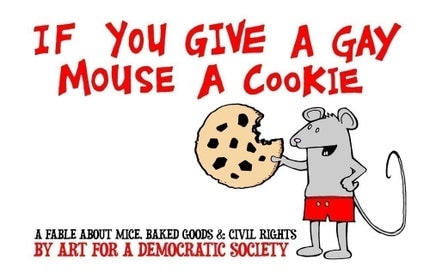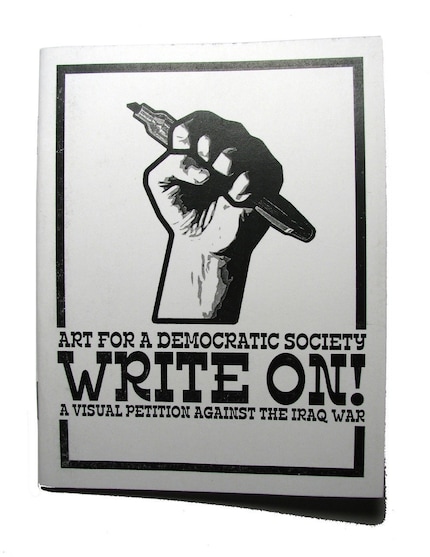
Above: "If You Give a Gay Mouse a Cookie" by Art for a Democratic Society
Please tell us what issues are important to you.
A4DS tackles a lot of different issues; we tend to focus on different political or local issues as they come up. Politically, our views are left-wing and there are many things about modern society that we think should change, and know can be different, but we don’t see A4DS as a way to initiate independent political actions; that is the role of grassroots activism in our view. Some of our goals or hopes are to be able to lend some support to existing movements as well as initiate public political exchange and debate on political issues. So, for example, we supported a labor action by locked-out Waste Management workers helping on the picket line as well as setting up a table in Oakland with markers and poster board and asking passersby to help create picket signs. In a small way, with projects like this, we can both lend concrete “artistic” support to an immediate cause, but also engage people around immediate issues in what we hope, is a fun and unexpected way. In addition to that labor action, we've done projects and pieces about the death penalty, gentrification, the economic crisis, elections, as well as art history, theory, and aesthetics.
How is the idea of activism apparent in your art?
Activism is central to what we do. What we make is really ancillary to a wider project usually conducted in the public sphere. Lately, we've been partnering with activist organizations to create cultural responses to issues at hand.
 We also hope it comes across in the manner that we operate and conduct our art projects. We not only stress grassroots discussion about political issues, but take a participatory and grassroots approach to our projects as well. One of our ongoing regular projects is called “The Polarizer” which is just a big blank tablet that has been divided into two columns. We set the tablet on an easel at a street corner and have people weigh-in on one side or other of a particular issue by writing a response on the appropriate side of the tablet. Some months, the question is a straightforward one with the responses acting as sort of an impromptu straw poll of an issue. Other months, the question is more abstract and so we might ask people to write their version of “utopia” on one side of the tablet or their idea of “dystopia” on the other.
We also hope it comes across in the manner that we operate and conduct our art projects. We not only stress grassroots discussion about political issues, but take a participatory and grassroots approach to our projects as well. One of our ongoing regular projects is called “The Polarizer” which is just a big blank tablet that has been divided into two columns. We set the tablet on an easel at a street corner and have people weigh-in on one side or other of a particular issue by writing a response on the appropriate side of the tablet. Some months, the question is a straightforward one with the responses acting as sort of an impromptu straw poll of an issue. Other months, the question is more abstract and so we might ask people to write their version of “utopia” on one side of the tablet or their idea of “dystopia” on the other.Right: "Write On!" by Art for a Democratic Society
Do you think political and environmental issues can be effectively addressed in art?
That's kind of a tricky question. What do you mean by "effectively addressed?" We think political art can be effective as art. We don't think political art by itself can be effective in creating social change. However, if we look at the history of social movements, art movements and cultural movements are intertwined within them. Artists can react to social struggles and create cultural directions that aid political movements, but political organizing is essential to social change.
Which artists do you admire who have an activist agenda?
Jeremy Deller, the Yes Men, Banksy, Favianna Rodriguez, Melanie Cervantes and Jesus Barraza, Packard Jennings. We are also in awe of many in the generation of artists who were politicized by the events of the early 20th century such as the horrors of World War I, the movements of the Depression-era, and opposition to fascism. Many of these well-known artists like Diego Rivera, Bertolt Brecht, George Grosz, John Heartfield, John Steinbeck and George Orwell chose to use their skills to try and address or reflect the changes going on in the world.
Tell us something about your process of creating.
One of us comes up with a kernel of an idea, usually when we're pissed off and talking about the latest political issue, and then we talk it out to expand it into something. Usually then we decide
whether it's something we'll make together or run with on our own for a while.
Left: "Community Consensus Manifesto" by Art for a Democratic Society
 We try not to be mechanical about it: we don’t just read the headlines and pick one to talk about. So it’s always something that we’ve been talking about, something immediate like the prop 8 vote or a local strike, or something that a lot of people around us at work or socially have been discussing and arguing about.
We try not to be mechanical about it: we don’t just read the headlines and pick one to talk about. So it’s always something that we’ve been talking about, something immediate like the prop 8 vote or a local strike, or something that a lot of people around us at work or socially have been discussing and arguing about.Once we have a basic idea of the issue we evaluate different ideas about how to present it. What we always try and consider is if it is open enough that we aren’t simply fishing for people to come to the same conclusions we may have, but that it’s specific enough to be challenging and hopefully elicit debate.
The way our political bias does fit into our process is in what issues we choose to highlight and the way in which we do. We don’t see change coming from establishment political parties, but through social movements, so when something like Prop 8 comes up, we tend not to have projects focused on the legal and constitutional issues involved (such as court challenges and lobbying and so on) but on the grass-roots side of the issue.
What is the name of your etsy shop?
http://a4ds.etsy.com
MORE ABOUT THE ART FEATURED ABOVE:
This is the result of one of our favorite projects, the Community Consensus Manifesto. We did a poll at Oakland's First Friday art walk asking people questions about art and its place in society, based on an agree/disagree scale of 1 to 5. The questions were statements taken from various art manifestos. Based on people's responses, and using an elaborate methodology, we created a consensus manifesto.
Another favorite project of ours, Write On! is a compendium of anti- war posters "defaced" by volunteers at First Fridays. We printed templates of anti-war posters publicizing a protest, featuring George W. Bush, Hillary Clinton, and Harry Reid and Nancy Pelosi, and then asked people to deface them. There was a wide range of responses, from violent (tearing out the face on one poster), to juvenile, to clever, to serious. We compiled the results in this zine, and put up
the original posters around town.
If You Give a Gay Mouse a Cookie is a little different in that it's all our original content and not a community collaboration. We came up with the story and dialogue together, and Steve illustrated it. It's a parody of the children's book "If You Give a Mouse a Cookie," and a parable explaining the Paris 1968 slogan "with the eating, comes the hunger" from the standpoint of the gay rights movement, specifically the right to marriage. It's also appropriate for children (though not too young, maybe).




Tonight August 4 there is a celebration concerning Gay marriage in San Francisco. Keep on making your art, it is a piece of the puzzle of human kind trying to figure out how to be free and respectful.
ReplyDelete